
by Ronald P. Millett, Eldon G. Lytle, and John P. Pratt
Reprinted from Meridian Magazine (27 Nov 2006).
©2006 by John P. Pratt. All rights Reserved.
| 1. Martineau's Qualifications |
| 1.1 Adopted Paiute |
| 1.2 Cryptography Training |
| 2. Ideographic Writing |
| 2.1 Modern Icons |
| 2.2 Pioneer Plaque |
| 3. Deciphering the Glyphs |
| 3.1 Principles of Cryptanalysis |
| 3.2 Locator Glyphs |
| 3.3 Flood Warnings |
| 3.4 Modern Location Symbols |
| 3.5 Hunting Scenes? |
| 3.6 America's Rosetta Stones |
| 3.7 Compactness |
| 4. Reactions to Martineau |
| 4.1 Detractors |
| 4.2 Supporters |
| 4.3 Paiutes Honor Martineau |
| 5. Hopi Prophecy Stone |
| 6. Conclusion |
| Notes |
The life-long research into Native American petroglyphs by LaVan Martineau, an orphan adopted into the Paiute tribe of southeastern Nevada and southwestern Utah, has resulted in detailed interpretations of the rock writings. His work, culminating in an interpretation of the famous Hopi Prophecy Rock, demonstrates a much greater information content in these picture-based drawings than was previously recognized. Martineau's research implies the existence of early ideograph-based writing systems that could convey detailed meanings without including phonetic sound-based components.
The man who adopted him, Edrick Bushhead, was single and handicapped. He had suffered an accident that removed one arm at the shoulder. He barely survived through small jobs and lived in an 8 by 10 foot sheep wagon. Yet, he invited LaVan to live with him according to the religious and cultural code of the Paiutes that all orphans be provided for. Bushhead remained a father figure to LaVan all his life.
Although LaVan was baptized into the LDS church as a child, other members of his family were not active members. His first real association with the church was through the Boy Scouts in Cedar City, Utah. He thrived on this activity and became an Eagle Scout in 1950. Mainly through his efforts and connections with the Paiutes living in Cedar City, the Explorer Troop specialized in Native American dance. Many of the older Paiutes taught the Explorers the dances and they performed throughout southern Utah.
 |
LaVan Martineau learned from the Paiutes that rock writing was based on many of the gestures used in Native American universal sign language. Sign language consisted of a few hundred gestures that could be combined together to communicate complex ideas between the various Native American tribes. Their spoken languages were so very different as to preclude any verbal communication, but the sign language was universal from the Paiutes of Utah, to the Pawnees of Nebraska or the Iroquois in New York.[2] Even though tribes such as the Paiutes worked diligently to preserve their culture and pass it on to their children, the generations on the reservation had taken their toll, and almost all of the knowledge of how to read the "rock writing," or tumpe po-op in Paiute, had been lost.[3]
An ideographic[9] writing system corresponds to a concept of language that has emerged only recently in modern linguistics, namely, that the words that we write or speak are merely an outward expression of the real thing, which real thing constitutes a "language of mind," as it were.[10] In ideographic writing, symbols may be viewed as representing the conceptual formatives of mind language directly (visible mind). In contrast, writing systems that are phonetically oriented represent the articulation of the outward forms (visible speech). Ideographs are also called ideograms, and ideographs which look like little pictures of the concept are sometimes called "pictographs." The ongoing research by John Pratt into the meanings of the constellation symbols and their interaction with other constellations in the heavens is another example of ideographic writing.[11]
Not many years ago, most cars in America had a gauge on the dashboard with the English word "Fuel" written on it. Now most of them have a little standardized picture (icon or pictograph) of a gasoline pump there instead. Why was that change made? Was it a step forward in communication, or backward toward a primitive picture writing system? What do you think?
 |
After reading this article, you will be able to read at least a few common petroglyphs without knowing how to say the word in any particular Native American language. You can think of the word in your own language. Thus, one picture is indeed worth a thousand words. In this case, that can mean one word in a thousand languages. Thus we think that at least some forms of ideographic writing have the potential to represent a superior method of communication.
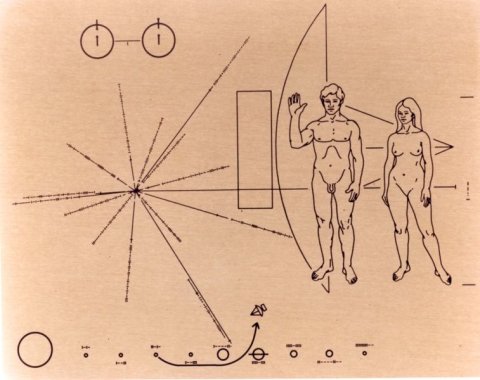 |
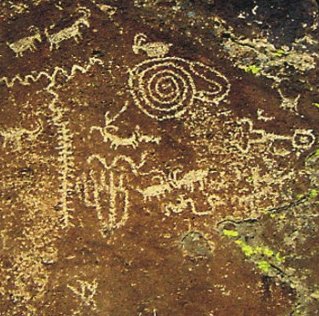 |
For several years he made little progress and most of his attempts to assign meanings to the symbols could not be consistently applied to another occurrence of the same symbol.[13] However, a major breakthrough occurred with what he calls "locator glyphs."[14]
 |
The spiral is to be traversed clockwise going from the outside top of the spiral and following it clockwise to the center of the spiral. It means "go up" and can be thought of as looking down on a hill and seeing a spiral path to the top. A similar spiral where a clockwise traversal would go from the center to the outside would mean "go down" (always go clockwise). The short line means "a short distance." The line curving to the right starting from the top means "go to the right." Fortunately, these locator glyphs are often also important parts of the larger, more complex panels. Once meanings could be assigned to the small locator glyphs, and checked against whether they give the correct directions and also against other similar locator glyphs, these meanings could then be the first steps toward decoding the complex panels.
It is the predictive power of cryptanalysis that makes it a science. For example, one need only check a large sample of locator glyphs to see if, in the case the indicated panels are above or below the locator, the spirals are consistent in indicating "go up" or "go down." Moreover, one could verify a lack of such spirals for panels on the same level. It would be another big step for an independent researcher to perform such a simple study to confirm or refute Martineau's claims for this one glyph. If even one such interpretation were firmly established by the scientific community, then the entire concept that the glyphs were meant to be read and understood would be validated.
 |
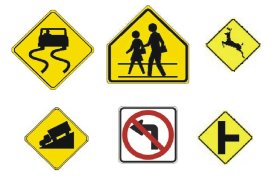 |
In America, text or numeric information is often included in these signs such as the steep grade or speed limit signs. In Europe, the road signs are more iconic containing less language specific text because of the many languages spoken in the countries that use these common road signs. There is an official international committee to standardize these symbols to become a truly worldwide ideographic language.[17]
To LaVan's amazement, after many years he discovered that the function of the quadrupeds, whether sheep, goats or horses, was to show action and movement in the writings and to add modifier attributes to that description. "In reading rock writings, then, it is very important not to confuse quadruped action with actual quadrupeds."[20] Decoding the meaning of the ubiquitous "hunting symbols" proved to be another great breakthrough in decoding the rock writings.[21]
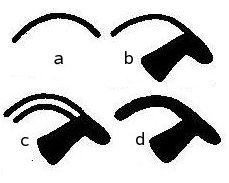 |
 |
Even with the progress that he had made, much of what compex panels depicted remained unknown to LaVan Martineau. Then he realized that certain panels and what he understood about them so far seemed to relate to known historical events, such as the Native Americans meeting with the Dominguez-Escalante expedition in 1776. There were versions recorded of these events in our history books and also in the memorized songs and stories of the tribes. These parallel versions could then be used to further decode panels because the same story had been told in three languages.[24]
One of the most interesting of these "Rosetta Stones" describes Kit
Carson's 1863 campaign to defeat the Navajos, who had been
raiding settlements for many years, and take them to a reservation in
Fort Sumner in eastern New Mexico.[25]
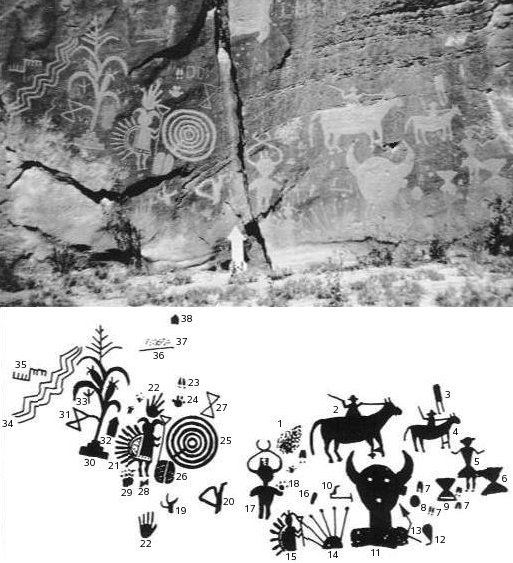 |
The rock writing describing this history is shown in Figure 6. Because the Native American languages had different word order and syntax, rock writings were not ordered in any particular way, such as our English left to right written format. In order to understand a panel, the entire panel had to be decoded. Related concepts are usually clustered together and sometimes the flow of information will be left to right or right to left in parts of the panel. This approach to telling a story with petroglyphs is like the interactions between adjacent constellations in the sky that are used to also tell a story.
It is interesting to note that the 38 fairly simple rock writing symbols in this panel are able to express the ideas from 370 English words using 1652 alphabetic characters (see oral history version of the story in previous footnote). This shows an important advantage of pictograph form of writing that can compress a tremendous amount of information into a small space. This is a 43:1 ratio of rock writing symbols to English alphabetic character symbols and almost a 10:1 ratio of rock writing symbols to English words. LaVan Martineau's explanation of this petroglyph and two other less complicated ones at the same location takes eleven pages. [26]
Only by painstaking research over many years and by studying thousands of examples from many places in the country was LaVan Martineau able to decipher this method of writing.[27] LaVan only would include in his publications interpretations that he was confident were right because they were based on many examples. These American "Rosetta Stones" provided a giant leap in further understanding the rock writings.
And now, behold, we have written this record according to our knowledge, in the characters which are called among us the reformed Egyptian, being handed down and altered by us, according to our manner of speech. And if our plates had been sufficiently large we should have written in Hebrew; but the Hebrew hath been altered by us also; and if we could have written in Hebrew, behold, ye would have had no imperfection in our record (Mormon 9:32-33).
In one study, a Hebrew translation of fourteen pages of the English Book of Mormon text could be written on one 7 x 8 inch page that is the estimated page size for the golden plates.[28] If reformed Egyptian were even more compact than that, then it might also have a compression ratio similar to the 43:1 character ratio of rock writing to English text in this example. The paradigm of using simple pictograms with complex interpretations as they interact with other pictograms certainly could be used in other situations than just petroglyph-based rock writing on cliff walls.
Dr. Hyder begins by saying that "Julian Steward was the first American anthropologist to publicly lament the array of fanciful ideas and pseudo arguments proposed to explain or interpret rock art. He argues that 'when competent archaeologists can be enticed to set aside their spades long enough to ponder petroglyphs, we may expect a much better understanding of this interesting subject.' Over 30 years have passed and little has changed."
Hyder rejects the notion that Martineau could know that the rock writings were related to sign language through his adoption into the Paiute tribe and their tribal traditions and knowledge. In evaluating some of Martineau's sources, Hyder notes that
"None of these early sources should be relied on without careful consideration of their goals, their sources, and the appropriateness of their data to your particular question. This same desire to 'defend the American Indian' drives the more recent work of Martineau (1973:xiii). He implicitly accepts the assumption that unless native Americans have a system of writing, then they are somehow inferior to other peoples (Martineau 1973:167). Nonsense! The history of human culture is far more complex than a simplistic division between literate and nonliterate cultures." [30]
In saying this, Hyder is playing social politics. While it may be politically correct in the anthropological community to claim that all cultures are equally sophisticated and advanced, nothing could be further from the truth. Preliterate peoples lack the fundamental technology for exchanging information in situations where people are divided by time or place. Education in a preliterate society is limited to apprenticeship — personal contact. Education in a literate society has no bounds.
Hyder does not mention the step by step analysis, the many, many examples, tables and especially the "Rosetta Stone" chapters in LaVan's book. He is stuck on square 1, whether it is writing or art, or at most the simple locator examples, for which he does not even really consider the extensive evidence.
One popular book totally ignores Martineau's work by lumping it together with that of rank amateurs. The author of Prehistoric Rock Art, who considers himself a highly qualified expert, being an engineer and tech writer, states in 1982:
"And despite all such earnest efforts by a few, it could safely be said that the serious scientific study of canyon country rock art has still not begun. . . . [Then alluding to Martineau's work:] Such "researchers" have little trouble finding whatever they wish to find in the crude scratchings of prehistoric cultures barely sophisticated enough in graphics concepts to make recognizable two-dimensional images by banging rocks together. But truly qualified scholars, trained in the rigors of the scientific method, will find rock art baffling . . ." [31]In other words, if the true scientific scholars can't make heads nor tails of the figures, then we can be absolutely sure that rank amateurs have no chance. And if card-carrying scholars can't read them, then no one can, and hence they are not writing at all but only "scratchings." His incredible bias against the intelligence of the Native Americans invalidates his own work as not at all objective.
John S. Curtis' paper entitled "Is it Really Art?" in the 12th annual symposium of URARA in 1992 presented a strong defense of Martineau's arguments that these petroglyphs are "rock writings" and not just "rock art":
"It is well known that the Indians had no formal written language. However, they had words in their language for writing and reading in the sense that writing was the making of records that could be read by others and that reading was the interpreting and understanding of these written records (Martineau 1973). In spite of this understanding, the white society has coined the phrase "Rock Art" to describe, collectively, petroglyphs and pictographs. This is a particularly unfortunate term since it not only denies the Indian ideas of what petroglyphs and pictographs are but it is a scientific abomination. The first rule of any scientific inquiry is that it must be done objectively. It is difficult to imagine anything less objective than naming the object of your studies with one of the conclusions which might be reached as a result of your studies.[32]
It would be a great thing if a result of the increasing respect that many now have for LaVan's work could help encourage the publication of more of his basic research notes and other writings by his Paiute family. This data on thousands of sites with detailed tables and notes would be a great treasure that might even help convince some of his critics as to the scientific basis for his studies and conclusions.
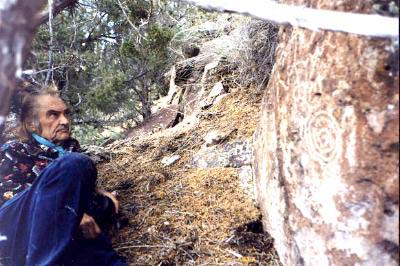 |
At the time of LaVan's death, a Sing was held
for him at the Shivwits tribal hall/school in Sham, Utah a few miles
west of St. George. The purpose of this event was to honor the man
and his accomplishments and to sing him on his way to the next life.
Farrel and his wife, Manetta, attended and were profoundly impressed
by the spiritual depth and sensitivity manifested by those in
attendance.[33]
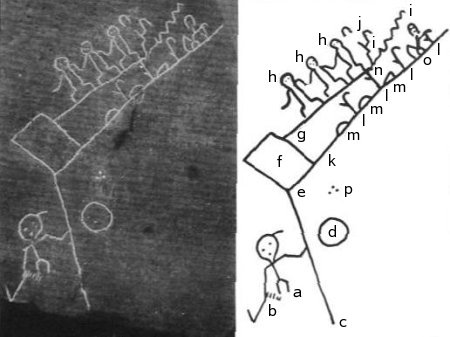 |
Symbol a represents the Creator pointing down close to the ground from where the Hopi claim to have come. The short vertical lines near the Creator's hand b represent the Hopi people. The Creator is holding in his left hand "the life plan" or "trail" c upon which the Hopi are to embark. Near this hand is a circle d which represents "holding" of the entire continent in trust for the Creator, as he had instructed. (Since this photograph was taken, viewers of this panel have added a bow to the right hand of the Creator which was not apparent when Martineau surveyed the carving.)
Point e on the trail or life plan represents a time when it was predicted by the Creator that the Hopi would digress from the true path given to them and pursue another way. The square f is said to represent Oraibi, and the line or path g coming down from the square represents the false path of the wicked Oraibi . . .
The figures h standing upon the false path represent the wicked themselves. Older Hopi claim that heads have recently been added to these symbols, for they remember a time when no heads existed on these figures. The absence of heads would represent the punishment or death that the wicked must undergo as a result of following the false path.
The two zigzag lines I stemming from the false path represent the careless and different paths to permanent destruction pursued by the wicked. . . .
Symbol k is the true path of everlasting life, symbol l, which is shown at four points along this true path. The incorporation of the symbol old age (a cane) with life (a branching corn leaf) represents everlasting life. . . . The Hopi say that they are gourds which are shaken, thus representing three great wars or shakings that will transpire before the everlasting life is reached. The last circle represents the "final war" of purification in which all evil will be destroyed.
At point n on this panel the false path connects with an everlasting life symbol, showing that some may return to the true path and to everlasting life. The two zigzag lines which extend beyond this point of possible return to the path of everlasting life thus truly indicate permanent destruction, since the wicked have gone beyond this point of no return. Symbol o, at the end of the path is the great spirit holding an everlasting life symbol in his hand. He is shown waiting here at the end of the trail just as he was shown at the beginning of it. For this reason he is called the first and the last.[35]
1. LaVan Martineau, The Rocks Begin to Speak, KC Publications, Las Vegas, 1973, and The Southern Paiutes, KC Publications, Las Vegas, 1992. His daughter Shanan has a website with updates, comments and links to where books are available at www.rocklanguage.com.
"The studies thus far pursued lead to the conclusion that at the time of the discovery of North America all its inhabitants practiced sign language, though with different degrees of expertness." (Quoting from Garrick Mallery, "Sign Language Among the North American Indians," First Annual Report of the Bureau of American Ethnology, 1881-1882, Washington D.C., p. 326).William Tomkins, American Indian Universal Sign Language, San Diego, Neyenesch Printers, 1948, at http://www.manataka.org/page310.html:
"There is a sentiment connected with the Indian Sign Language that attaches to no other. It is probably the first American language. It is the first and only American universal language. It may be the first universal language produced by any people. It is a genuine Indian language of great antiquity. It has a beauty and imagery possessed by few, if any, other languages. It is the foremost gesture language that the world has ever produced."
"Many Indian tribes have become extinct, and their languages and cultures lost. Tribes who . . . were quite fluent in the sign language in the nineteenth centure (Paiute, Pima, Papago, Maricopa, Zuni, and Arizona Apache, for example) no longer retain even a memory of having once used it. Likewise, the art of pictography of the ancients has vanished. An Indian may gaze upon rock writings with the same curiosity that a white man might exhibit. . . . Some tribes, fortunately, have been a little more reluctant to abandon their cultures. Strongholds of Indian tradition, religion, and cultural traits still exist in scattered pockets throughout the nation."
"While serving in Korea, the Air Route Traffic Control Center in which I worked shared a quonset hut and adjacent rooms with the cryptography department. Adding to my good luck, seven of my eight tentmates worked in this crypto department. I, by proximity, because keenly interested in the subject and eventually having already had the required security clearance, learned from my more experienced tentmates many of the principles used in deciphering codes and ciphers. Obtaining knowledge of cryptanalysis in this manner was especially fortuitous, since authoritative books on the subject would have been very difficult to obtain because of the military value of this science."
5. Martineau, 1973, p. 175, quoting Schoolcraft (1853):
"It is remarkable that the system of pictography of the North American Indian becomes universal to the cognate tribes, at the moment that its symbols are committed to record. ... this system of picture writing was as familiar to the Dakota as we had found it among the algonquin race."
6. www.answers.com entry for alphabet:
"A system of writing, theoretically having a one-for-one relation between character (or letter) and phoneme (see phonetics). Few alphabets have achieved the ideal exactness. A system of writing is called a syllabary when one character represents a syllable rather than a phoneme; such is the kana, used in Japanese to supplement the originally Chinese characters normally used. The precursors of the alphabet were the iconographic and ideographic writing of ancient man, such as wall paintings, cuneiform, and the hieroglyphic writing of the Egyptians. The alphabet of modern Western Europe is the Roman alphabet, the base of most alphabets used for the newly written languages of Africa and America, as well as for scientific alphabets. Russian, Serbian, Bulgarian, and many languages of the former Soviet Union are written in the Cyrillic alphabet, an augmented Greek alphabet. Greek, Hebrew, and Arabic all have their own alphabets."http://home.vicnet.net.au/~ozideas/writalfa.htm:
"The reason for the great advantage of the alphabet is that in most languages the number of phonemes (speech sounds) is only around forty, with a range of between twelve to sixty, a limit probably due to the restricted range of sounds that humans can distinguish in listening or articulate in speaking. It defines the maximum number of letters needed to represent them, that need to be learnt. Since the necessary letters are so few in number, they can be simple and distinctive, and easy to write and to copy. In a consistent spelling system, any unfamiliar word can be written down by analysing the speech sounds, and it can be read by combining the written symbols (graphemes ). A writer may misspell, and still communicate in an alphabetic writing system, whereas logographs are not so immune to misinterpretation through human error or memory lapse in writing or reading."
7. www.answers.com entry for logogram:
"A logogram, or logograph, is a single written character which represents a word or a morpheme (a meaningful unit of language). This stands in contrast to other orthography, such as syllabaries, abjads, and alphabets, where each symbol primarily represents a sound or a combination of sounds. Chinese characters, used in Chinese and Japanese, make up a logographic system. Written Korean used a subset of Chinese characters as well until widespread use of Hangul after World War II, as did Vietnamese before French missionaries arrived in Indochina. A good example of modern Western logograms is the numbers - 1 stands for one, 2 for two and so on; the ampersand & is used for and, while @ sometimes stands for at. Compared to alphabetical systems, logograms have a disadvantage in that one needs many of them to be able to write down a large number of words. An advantage is that one does not necessarily need to know the language of the writer to understand them - everyone understands what 1 means, whether they call it one, eins, uno or ichi. Likewise, people speaking different Chinese dialects may not understand each other in speaking, but often can in writing, especially if they write in standard written Chinese. In addition, a logogram-based system uses fewer characters to express something than an alphabetic system ..."www.answers.com entry for Japanese:
"In the 3d and 4th cent. A.D., the Japanese borrowed the Chinese writing system of ideographic characters. Since Chinese is not inflected and since Chinese writing is ideographic rather than phonetic, the Chinese characters do not completely fill the needs of the inflected Japanese language in the sphere of writing. In the 8th cent. A.D., two phonetic syllabaries, or kana, were therefore devised for the recording of the Japanese language. They are used along with the ideographic characters (or kanji characters) to indicate the syllables that form suffixes and particles."
8. www.answers.com entry for Egyptian Hieroglyphics:
"Hieroglyphs are a system of writing used by the Ancient Egyptians, using a combination of logographic, syllabic, and alphabetic elements."There is a hieroglyphic dictionary at http://www.jimloy.com/hiero/e-dict.htm and an interesting site for numbers and fractions is http://www.greatscott.com/hiero/.
www.answers.com entry for Maya hieroglyphics :
"Maya hieroglyphics is the system of writing used by the pre-Columbian Maya people to record the Maya language. It consisted of a highly elaborate set of glyphs which were laboriously painted on ceramics, walls or bark-paper codices, carved in wood or stone, or molded in stucco. The decipherment of the writing was a long and laborious process. 19th century and early 20th century investigators managed to decode the Maya numbers and portions of the text related to astronomy and the Maya calendar, but understanding of most of the rest long eluded scholars. In the 1960s progress revealed the dynastic records of Maya rulers. Since the early 1980s it has been demonstrated that most of the previously unknown symbols form a syllabary, and progress in reading the Maya writing has advanced rapidly since."Examples of Mayan hieroglyphics: http://www.crystalinks.com/mayanscript.html:
"For a long time many scholars believed that the script did not represent a language at all, or that it wasn't a complete writing system. The first major breakthrough in decipherment came during the 1950s when a Russian ethnologist, Yuri Valentinovich Knorosov, proposed that the Mayan script was at least partly phonetic and represented the Yucatec Mayan language. His ideas were not welcomed by other Mayanists, but he was eventually proved correct. Further progress in the decipherment was made during the 1970s and 1980s when more linguistics began to take an interest in the script. Today most Mayan texts can be read, though there are still some unknown glyphs. A gripping account of the decipherment of the Mayan script can be found in Breaking the Maya Code, by Micheal D. Coe. . . . The Mayan script is logosyllabic combining about 550 logograms (which represent whole words) and 150 syllabograms (which represent syllables). There were also about 100 glyphs representing place names and the names of gods. About 300 glyphs were commonly used."
9. www.answers.com for ideogram:
"Ideograms are said to be graphical symbols that represent words or morphemes. They are composed of visual elements arranged in a variety of ways, rather than using the segmental phoneme principle of construction used in alphabetic languages. The effect is that while it is relatively easier to remember or guess the sound of alphabetic written words, it is relatively easier to remember or guess the meaning of ideographs. Chinese characters are conventionally called ideographs or ideograms, but their own linguistic tradition divides characters into at least five categories, of which 'ideograph' is a plausible translation of only one or two."
10. Eldon G. Lytle, Junction Grammar: Theory and Application, Linguistics Association of Canada and the United States (LACUS), 1979:
"There is no semantic component per se in the [Junction Grammar] model. The 'meaning' of an utterance is considered to be what a person experiences throughout the data systems as a consequence of what it stimulates in them collectively. If purely acoustic phenomena such as rhythm, rhyme, cadence, sound -symbolism, etc. evoke responses independently of any conventional symbolic associations, then those responses are considered to be part of the meaning of an utterance. This point of view is supported by the homage rendered such phenomena in literature, especially poetry, not to mention the role of chants, verbal charms, etc."See also: William Harris, Kinder-ur-Sprache in a Word-Tagged World - Words: Where coming from, and Where leading to? Middlebury College, Vermont, 2003 at community.middlebury.edu/~harris/Philosophy/language.html:
"We are having a hard time! Behind all these interleaved processes we are still not exactly sure what is meant by Mind as a function of the brain. In the animal world other species have Mind too, often better than ours for purposes which we cannot exactly define or even imagine. The world flowing in on us is too big to grasp, we devise systems for dealing with it summarily in its many parts. We rely first on words and the code of language, then we devise other ways through the Arts to represent reality and un-reality. All the time we are confident of what we have accomplished, tagging and inventorying the world with Words, talking endlessly with each other about something, or often nothing, busy with the world of notions which we have constructed around There is further to go in grasping this world, much more to understand and more to guess, beyond the thinking which we do with the code of language, beyond the codes of computers, beyond our imagination. Language can search-and-find anything which we have coded as words, and it does this search remarkably well and efficiently. But there is thought beyond what we have tagged and coded, a world of Mind without tags."
11. Pratt, John P., "Enoch's Constellations Testify of Christ," Meridian Magazine (23 Aug 2006), and "Constellations Testify of Seven Angels," Meridian Magazine (28 Sep 2006).
12. There is an explanation at en.wikipedia.org/wiki/Pioneer_plaque.
"In this period from 1956 to 1960, few symbols were actually deciphered, although many had been assigned tentative meanings. All but a few of these first guesses were eventually scrapped when they failed to pass the tests of consistency (having the same meaning each time used), the basic requirement of any writing system which is meant to be understood."

14. Martineau, 1973, p. 17-18 (Figure 10):
The figure shows the simplest locator basic symbols: (a) two eyes showing direction, (b) go a certain distance (line length shows short or long), (c) going up (clockwise winds to center from outside of spiral), (d) coming down (clockwise winds from center to outside of spiral), (e) cross over, (f) writings or talk (two heads with speech between them), (g) go around, (h) near or close, (i) looking ("eleven examples in which these two eyes lines up and pointed at a hidden panel were found."), (j) missed ("you missed something in that direction").
17. See www.ergoweb.com/news/detail.cfm?id=852.
"Almost everyone who has seen the mystifying symbol of an animal resembling a mountain sheep has been curious to know its purpose. Such scenes as those in which sheep are being shot at by men with bows and arrows naturally prompt theories that they illustrate hunting episodes, or that they are ritual figures once used in hunting magic. But such theories do not hold up under close examination. Hunting was so common among Indians that it would hardly have merited such a one-sided and profuse depictions. Indian legends commemorate only the unusual hunt or the unusual animal. Furthermore, mountain-sheep symbols are found in some areas where there is no proof that this animal ever existed! "
Grant, 1967, p. 32:
"Wherever naturalistic animal rock pictures are found, it is almost certain they were made as hunting magic or to increase the supply of game."
19. Martineau, 1973, p. 8, Figure 5.

"This figure shows the variety of uses for human and quadruped figures to show action and modify other pictographs. (a) movement straight ahead, (b) blocked movement, (c) lying down, (d) starting out (profile figure), (e) lateral action to the left, (f) lateral action to the right, (g) uphill, (h) downhill, (i)(j) death ('the concept of death, however, can be demonstrated equally as well by the human form as it can by the quadruped.')."

21. Martineau, 1973, p. 56-7, explains a petroglyph found on the north rim of the Grand Canyon describing a journey into the canyon almost entirely using variations on quadruped animal figures:
"Symbol a depicts the rim and the depths of the Grand Canyon. . . . Symbol b represents a figure beckoning this tribe to come and stay. This is indicated by the position of the arms — one is beckoning, and the other is pointing to the ground. . . . Goat d has horns with an up symbol. It is doubled to be off from up. Goat f horns indicate distant or far up, emphasizing the height of the rim seen from below. Goats g, h, and i have a teardrop or darkened eye symbol which are canyon symbols as they descend into the canyon. The hand holding human figures in j and k further clarify the description of the journey. . . . This group had just departed and had not gone far into the canyon when they halted their journey (probably temporarily). The goat m is positioned above and to the right of symbol b to indicate first, superior, or before. . . . [It] probably refers to a scout who visited the other side and then went off the top."What an amazing amount of information from what others might consider just a "hunting scene!"
23 . For more on the Rosetta stone see en.wikipedia.org/wiki/Rosetta_Stone.
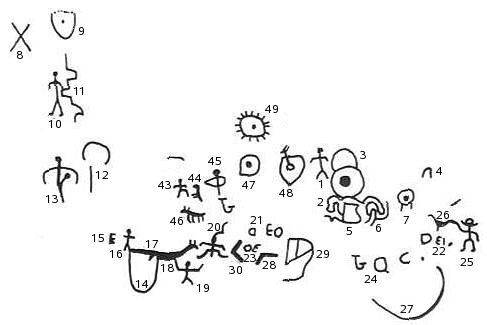
24. Martineau, 1973, p. 85-91. This petroglyph shows the Indian account of the 1776 Dominguez-Escalante expedition on their way south crossing through what is now Washington Country, Utah. The Indian guides tried to lead them toward the Colorado River Lee's Ferry crossing. But as they reached a narrow portion of a canyon, the Spaniard's horses would not go further. Fearing that they would be blamed, the guides fled to the top of the canyon. The Spanish continued south as they intended, heading toward the impassible Grand Canyon. Note the "deo" (21) and "dei" (22) showing latin words "to God" and "of God" that the Indians drew to show the unusual method of writing that the Spaniards used. Symbol 20 emphasizes the wide canyon trail they eventually took.
25. Martineau, 1973, pp. 95-97. Here is the Navajo oral account of the story:
"The white soldiers came into the land of the Navajo, and sought to make us believe them and go with them to another land. In order to accomplish this they made their camps in our cornfields, piled the corn up, and burned it. They also killed most of our sheep. Instead of submitting to surrender, however, we closed our ears to their words and would not believe them. We relied upon our strength and retreated to a rough canyon (Canyon de Chelly), wherein we could hide and fight. The soldiers entered this canyon in the midst of winter to punish us and make us believe what they said. They had difficulty in passing through the canyon, and some soldiers broke through the ice and hurt (froze) their feet. Those of our people who were in the bottom of the canyon at this time fled to the tops of the cliffs where they could have a better hold, and could fight from above. But we were suffering from hunger and could not fight as effectively as the soldiers below. Thus we showed little resistance. Many of our people who were watching from their hiding placed later left these places to surrender to the soldiers in order to obtain blankets, get food to heal their hunger, and warm themselves by the fires. We thus sought the safety of the soldiers. Those who had made a defiant stand were captured and confined to prison. Those who escaped were pursued. Those who refused to leave the canyon were killed and mutilated. Because of our hunger, the killing of most of our sheep, the war upon the corn, and the pursuit of those who fled, the hand of death was placed in our path. In our weakened condition, and in order to heal our hunger, we surrendered. Thus we left the dangerous path of fighting behind us, and this war upon us and our corn–so harmful to both our land and ourselves–ended. After our surrender, we journeyed across a large river (Rio Grande). Here some of our people drowned and were carried away by the current. This journey took us to a flat land upon which the soldiers lived and where we were to stay."
26. Martineau, 1973, pp. 98-105. We will only relate a small part of LaVan Martineau's decoding of this panel. The reading could be started in many places, but symbol 1 is a good place to start. The outline is a teardrop symbol used to represent a canyon (the Canyon de Chelly), but it is roughly pecked to indicate a rough canyon. This rough pecking has been smoothed over to indicate a good place for the Navajo to hide and fight. "Symbol 2 is a soldier wielding a club or sword with which to punish the Navajo. The line across his head is sign-language for white man (hat) . . . Symbol 3 is used in this panel to represent winter. It is a 'second suit of clothing' for warmth. . . . Symbol 5 is a retreating Navajo 'cut in two' from hunger. He is attempting to fight, indicated by the war symbol 6 — two arrowheads pointing at each other — superimposed over a corner of his hungry body. The top arrowhead is poorly and indistinctly made, to indicate the lessened ability of the Navajo to fight due to their hunger. . . . Symbol 23 is again the symbol fleeing, and the symbol 24 is the track of a pursuing mountain lion. These two symbols indicate the if the Navajo fled they would be pursued. . . . Symbol 25 is many circles (holding), all bunched into one to indicate many holding. It refers to the large flocks of sheep the Navajo owned. Note the sheep track below (26). This sheep track is cut (not pecked) with many diagonal lines to show that many sheep were killed."
27 . Martineau, 1973, pp. 14, 28. The first chart compares
petroglyphs from Washington county, Utah (A) to other parts of the country (B).
The second chart shows how simple figures can be modified by
combination and incorporation into more varied figures.

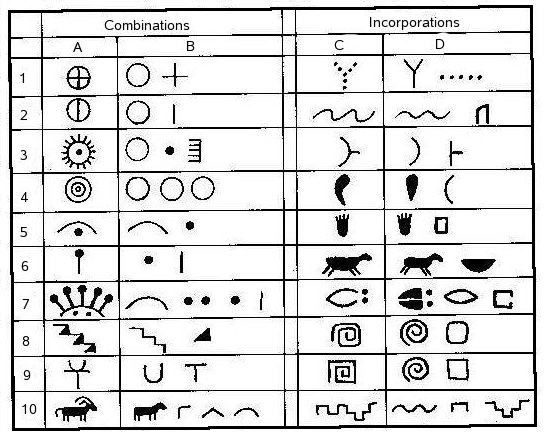
See also the summary table that shows many of the symbols used in rock
writing and their interpretations from LaVan Martineau's lifetime
of research. (Martineau, 1973, Chart 8, p. 160). See also Dominique
Ballereau, "A Complete Survey of Petroglyphs
from Cerros La Proveedora and Calera, Sonora," Rock Art Papers,
Vol 5, Edited by Ken Hedges, San Diego Museum Papers No. 23, 1987.
An amazing paper that shows the wide variety of petroglyphs
including the semantic variations that are described by Martineau.
pp. 102-106.
28. Janne M. Sjodahl, "The Book of Mormon Plates," Provo, Utah: FARMS, 2001. Journal of Book of Mormon Studies, Vol 10, No. 1, pp. 22-24:
"On a space seven by eight inches, my friend, Brother Henry Miller, a Hebrew by birth, has written with pen and ink fourteen pages of the Book of Mormon text, translated into Hebrew, using the square letters in which the Hebrew Bibles now are printed. That is to say, the entire Book of Mormon, fourteen pages of the American text to each page of Hebrew, could be written on 40 3/7 pages — 21 plates in all. Brother Miller positively states that, even if the compilers of the Book of Mormon used much larger characters than he has used in this copy, they could have engraved the entire text on 48 plates."This article originally appeared in the April 1923 issue of the Improvement Era. http://farms.byu.edu/display.php?table=jbms&id=236#3.
29. William D. Hyder, "Some Problems in the Use of Sign Language to Interpret Rock Art" Paper presented at the 15th annual meeting of the American Rock Art Research Association (ARARA), Ridgecrest, CA. May, 1988.
30. Hyder, 1988. Here are more of his arguments:
"Where do I find fault with the use of sign language to interpret rock art? The most obvious criticism is that the arguments are circular. The argument typically flows as follows: rock art symbols are sign language symbols, sign language symbols can be used to "read" a particular panel, therefore the proposition that rock art symbols are sign language symbols is self proving. How can we better evaluate the use of sign language to interpret rock art? The logical place to start is with the basic hypothesis that rock art is actually rock writing (Martineau 1973:3). There is nothing inherently wrong with this hypothesis, except that in Martineau's work it becomes the assumed fact that the rest of the work is built upon. ... In short, Martineau gives us no reason other than faith to accept or reject his assumption. If we reject his assumption, the rest of his argument is irrelevant. But, let us accept it for the moment as a hypothesis and evaluate his work as its test. If we ignore sign language for the moment and just look at Martineau's (1973:16-23) proposed locator signs we could begin to evaluate a part of his argument given sufficient data. The evaluation would take into account the number of times a given locator sign correctly pointed to a hidden water hole, cave, or other rock art panel, versus the number of times it did not. How many correctly identified sites would constitute a sufficient number cannot be answered in the abstract. One out of one is clearly too few; 1,000 out of 1,000 clearly enough; and 50 out of 100 would certainly warrant further study. I suspect that we will recognize a reasonable argument if and when adequate data are produced."
31. F. A. Barnes, Prehistoric Rock Art, Wasatch Publishers, Salt Lake City, Utah, pp. 27-28.
32. John S. Curtis, "Is it Really Art?" 12th annual symposium of Utah Rock Art Research Association (URARA), Price, Utah, Vol 12, 1992. See also Ancestral Art website, www.ancestral.com/meaning.html:
"Some primitive art can be deciphered directly. There are several reasons for this. The art often matches a known historical event, such as a battle, encounter with Europeans, or a celestial event such as a constellation or supernova. Other times, a group's oral traditions provide an explanation, although this can become corrupted over time.
"LaVan Martineau is a United States [Air Force] trained cryptographer who was raised by members of the Paiute tribe. He applied standard cryptographic techniques to rock art and argues that -- in addition to the obvious hunting rituals, religious symbolism and doodles -- much rock art consists of travel directions, instructions, warnings, tribal or clan signs, and individual signatures.
"Many rock art scholars disagree with him, arguing that Martineau has over-generalized, and that his conclusions are simply not supported by the facts and are nothing more than wishful thinking, and that, despite being raised by a Native American tribe, he lacks any formal training in Native American cultures. Even if you do not agree with all of his points, his book is still a fascinating read. . . .
"Martineau wrote that if rock symbols were anything other than decoration or magical symbols they would, of necessity, have some easily decipherable meaning:
"If Indian rock writings were meant to convey any information at all which might have been read and understood by other Indians of the same time and area, the symbols would have had to contain a distinguishable consistency."
33. Ferrel W. Lytle, home.comcast.net/~carlbjork/Marineau.html
"My short acquaintance with LaVan has profoundly changed my view of the Indian culture. Too much of our image of Indians and their culture has been the result of movies. Archaeologists have unearthed and documented the lasting (stone and bone) artifacts of their long-ago culture and have had no way to reach the non-material aspects. Our western society is based so much on material objects that we can't imagine what a culture based mainly on religion, history and story would be like. No TV, no movies -- not even any light at night. And every year during those long winter evenings, the history and traditions of the tribe were taught by the elders in the form of songs and stories. Many of the petroglyphs tell the same stories. I was moved by the persistent integrity of the Paiute culture as represented in their process of mourning. The tribe is healthy and vibrant. People work in the local economy and are prosperous. Some of the youth are learning the old songs and traditional ways."
LaVan's obituary: http://www.obitcentral.com/obitsearch/obits/misc/anthro16.htm:
"DOUGLAS LAVAN MARTINEAU, 68, specialist in petroglyphs, died on February 26, 2000, at home in his trailer while visiting with his daughter in St George, UT. Born January 3, 1932 in Kanab, UT, to Amon Douglas Martineau and Mavis Soren son, Martineau married Doris Dorene Kanosh in 1954 in Moab, UT. She died giving birth to their son, LaVan Jr in 1958 and he later married Evaline Mae McFee in 1962. She preceded him in death in 1996.After his father died in 1950, Martineau was raised by Edrick Bushead, a Paiute who lived at the Cedar City Indian Village. He grew up learning the language and culture and later married into the tribe. He served in the US Air Force during the Korean War as an air traffic control operator.
Martineau was an author with several books under the publication of KC Publications, his best known work being The Rocks Begin to Speak and The Southern Paiutes. He also did work on Indian sign language, Indian archery and his most recent book, The Great Migrations and the Indian Prophecies, is still in the publishing process. He was greatly admired for his interpretation of petroglyphs. He combined his knowledge of spoken Indian languages, Indian sign language, the histories of the tribes and the best ethnographic background possible with thousands of observations and then attempted a self-consistent, logical system of the meaning of the symbols. It is hoped that his family will place his papers where they will be available for future scholarly study.
Martineau had many interests, his favorite being his love for the great outdoors and travel worldwide to learn about the different cultures of the North American Indians. He was a warrior in life, always searching for new battles to conquer and ways to preserve the culture of others so that they might have knowledge for generations to come.
Martineau is survived by daughters Carmen Martineau, Shanandoah Martineau, Jetta Wood and Dorena Martineau, and five grandchildren. (Farrel W. Lytle)"